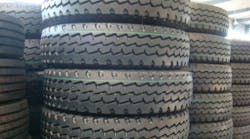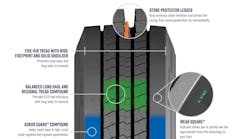It’s a well-worn cliché in the trucking business and yet it still holds true in the main: tires really are “where the rubber meets the road” in terms of productivity, uptime, and efficiency in the freight world. Tires are also one of the trucking industry’s major expenses, representing about 2% of overall costs.
And the impact of good tire management is felt far beyond simply buying, retreading and disposing of them. For example, the North American Council for Freight Efficiency (NACFE) studied the relationship between tire rolling resistance and fuel savings in a Confidence Report released two years ago and found that the lower the rolling resistance of a truck or trailer tire, the greater the fuel savings possible—even when the wear rate of a low rolling resistance (LRR) tire is faster than that of “standard” models.
“Tires have a much bigger impact on overall fuel economy than many believe,” noted Mike Roeth, NACFE’s executive director, emphasizing that the cost of the fuel consumed as it relates to tires can be five times greater than the initial purchase price of the tire.
While the typical upfront price of a tire is about four cents per mile, given the range of rolling resistance among dual tires, NACFE’s research indicated that tires could actually account for anywhere from 14 cents to 28 cents per mile in fuel costs.
So how does a fleet keep a firm handle on such an expense? Fleet Owner touched base with Gary Schroeder, director of the truck and bus tire business division at Cooper Tire & Rubber Co., which includes the Roadmaster tire brand, to provide some tips for fleets when it comes to tire care practices:
Maintaining proper tire pressure seems to be the number one thing a fleet can do to help prevent tire failures on the road. What kinds of technologies can fleets use to help improve maintenance of tire pressures?
Schroeder: Fleets should consider using tire pressure monitoring systems (TPMS) on trucks and continuous tire inflation systems (CTIS) on trailers in order to simplify and improve tire pressure maintenance. Improved tire pressure maintenance will help improve fuel economy and tire wear. Having a strong tire maintenance program that includes regular tire inspections can ensure tires meet Federal Motor Carrier Safety Administration (FMCSA) Compliance, Safety, Accountability (CSA) program requirements, helping to keep drivers safe and help keep your truck on the road. [Here's more information about the safety rules that surround commercial vehicle tires.]
What are some of the visual ‘warning signs’ that appear when a tire may be at a higher-than-normal risk for failure?
Schroeder: Visual warning signs can include cuts, cracks, splits, punctures, irregular wear and bulges in the tire.
Additionally, tread depth is an easy to spot indicator of potential trouble. Tires that are nearing the end of their tread life are more susceptible to punctures or cuts. Steer tires must have 4/32-in. of tread depth and other tires must have 2/32-in. You can ensure there is adequate tread depth for the wheel position by using a tread depth gauge.
However, it’s important to note that visually assessing tire pressure is impossible, and maintaining proper tire pressure is the single most important factor in extending tread life.
Note, however, that the correct inflation pressure is determined by the load carried for each tire.
Both over- and under-inflation can have negative effects on the tire by changing its footprint, which is the area contacting the road.
Under-inflation can cause excessive heat buildup and can potentially cause internal structural damage, while over-inflation can make tires more vulnerable to cutting, punctures or damage from sudden impacts.
When the tire is not contacting the road as the tire design intended, the tread area will also wear irregularly and therefore more rapidly.
How can drivers help ensure the tires on the tractors they’ll be operating are good to go and not at risk for failure? Is there a ‘checklist’ of tips they can follow?
Schroeder: Making a conscious, proactive effort to focus on tire maintenance and replacement is important to the performance and safety of tires.
We recommend establishing a comprehensive maintenance program that includes regular inspections in the shop and by drivers before beginning a journey and while on the road. – as well as using a calibrated pressure gauge to obtain an accurate air pressure reading.
Drivers should check for proper tire pressure, tread depth and irregular wear. When properly maintained, serviced and inflated, tires are less likely to have a failure and will last longer. Tires and wheels/rims should also be thoroughly inspected on a regular basis, before each trip and daily during continuous service.
What are the most common causes of tire failures while on the road?
Schroeder: The most common roadside emergencies we see that are related to tires come from road hazards, improper maintenance, and conditions related to excessive heat.
Road hazards can be caused by punctures in the tire and impact damage from hitting curbs or pot holes. Maintenance related conditions can include excessively worn tires and improper tire repair. Excessive heat can be caused by under-inflation, over-inflation, and excessive vehicle speed.
How do heat and cold affect tire life?
Schroeder: Cold weather can cause tire pressure to drop, while heat can increase tire pressure. Both conditions could possibly lead to tire failure if not monitored.
Big swings in temperature can significantly change tire pressure so it is important to check tire pressure if you are traveling from a cold northern climate to a much warmer southern climate.
That’s one reason why educating drivers about the proper air pressure for each wheel position is important.
Finally, are retreads more susceptible to road failures than new tires?
Tires retreaded by a quality retreader should not be any more susceptible to road failures than new tires. We believe in order to get the most out of your tires, it’s important to find a brand that will provide long miles to removal, as well as one that takes into account the casing quality and belt package. The casing quality will tell you a great deal about the tire – how it will hold up, and the value the tire has for its second and third life in retreading.




